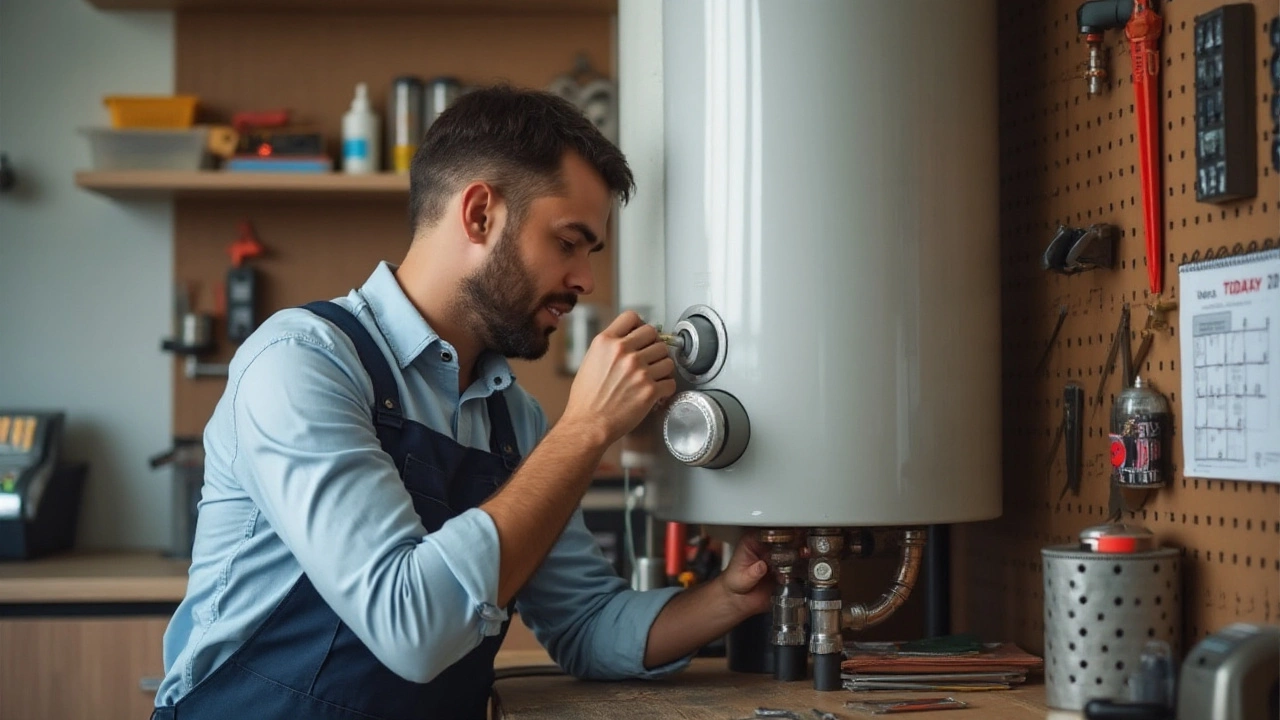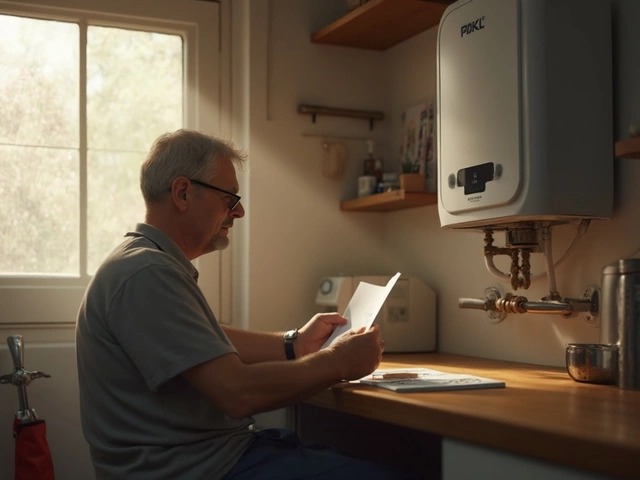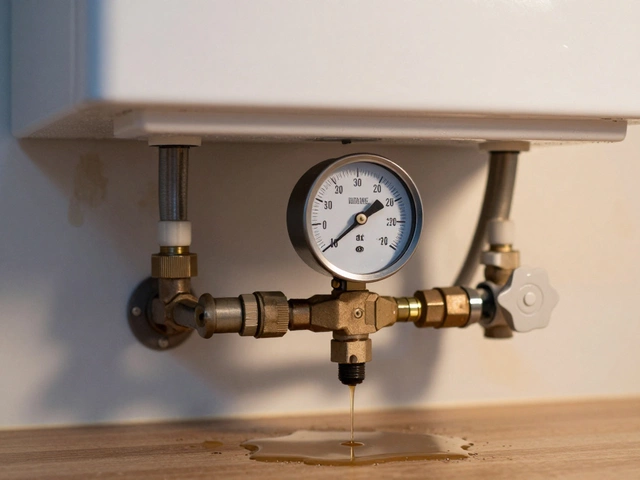When it comes to keeping your water heater in top shape, few components are as important yet overlooked as the anode rod. This often unseen piece of metal plays a key role in preventing corrosion and extending the life of your water heater. But how much does it cost to replace this critical component? Understanding the costs and the process can help homeowners make informed decisions about water heater maintenance.
In this article, we'll explore everything you need to know about the anode rod – from the different types available to the warning signs it might need replacement. Whether you're thinking of tackling this task yourself or hiring a professional, knowing what influences the cost is vital. Armed with this knowledge, you can better maintain your water heater's health, ensuring warm showers and lower energy bills for years to come.
- Understanding the Role of an Anode Rod
- Types of Anode Rods and Their Costs
- Signs It's Time to Replace the Anode Rod
- DIY Replacement vs. Hiring a Professional
- Factors That Influence Replacement Costs
- Tips for Maintaining Your Water Heater
Understanding the Role of an Anode Rod
An often unsung hero in the machinery room, the anode rod in your water heater is critical to keeping everything running smoothly. It's a metal rod, usually made from aluminum, magnesium, or zinc, that acts as a sacrificial component. The main job of the anode rod is to protect the steel tank from rusting, by drawing corrosion to itself, thereby prolonging the life of your water heater. Picture it as the silent guardian, tirelessly working in the background to save your water heater from imminent ruin. It's almost breathtaking how such a small piece of metal can have such a huge impact on your home appliance's durability.
The material of the anode rod can influence its performance. Magnesium anode rods are typically used as they are more effective at attracting corrosive elements; however, they can degrade more quickly. On the other hand, aluminum rods last longer but might not provide as high a level of protection in areas with hard water. Interestingly, while a mag rod might only last a few years in a hard water areas, an aluminum rod can hold out significantly longer before needing a replacement. Consider the local water quality before deciding which rod will best suit your needs. A little foresight can save you not only money but also headaches down the line.
How does one know if the anode rod is doing its job? A worn-out rod is a clear indication you've avoided rust successfully but reaching that point of deterioration signals it's time for a replacement. A solid rule of thumb is to check the rod every one to three years. Better yet, make it an annual event on your home maintenance calendar. If the rod has been reduced to less than half an inch of its original diameter, or if it's covered in calcium, it's no longer offering the protection you need. It's like that moment when you realize a tire has served its time after countless miles on the road and swapping it for a new one ensures safety.
"Regular inspection of your water heater's anode rod can extend the device's lifespan by up to 50%, resulting in significant financial savings over time." -Energy Star
It might surprise many to learn that during the life of a hot water tank, the actual cost of replacing anode rods is generally less than the cost incurred from the additional energy consumption of a failing system. Considering anode rods cost just a fraction of the price of a new heater, they represent one of the most overlooked proactive maintenance steps a homeowner can take. Knowing about your anode rod isn't just about extending the heater's lifespan; its conscientious maintenance can also enhance efficiency, thereby putting less strain on the environment and your wallet.
Types of Anode Rods and Their Costs
Navigating the variety of anode rods available can feel like a trip down a metal-laden rabbit hole. Each type has its own merits, costs, and ideal scenarios. Knowing which works best for your water heater is vital in making a sound choice. Essentially, there are three primary types of anode rods – magnesium, aluminum, and a hybrid aluminum-zinc alloy. Each serves its own purpose and is suited for specific conditions.
Magnesium anode rods are popular for their efficiency at preventing corrosion. They are known for generating a stronger electric current compared to other materials, which in turn offers better protection for your water heater. However, they generally come with a heftier price tag. Expect to spend between $20 to $40. Although more expensive, the longevity and quality of protection they provide make them a worthy investment.
On the other hand, aluminum anode rods serve as a cost-friendly alternative. They typically range from $15 to $30. While they don't produce the same powerful current as magnesium rods, they are useful in areas with hard water conditions. Aluminum rods are less prone to corrosion build-up, ensuring that flammable gases do not collect in your water heater. This results in a safer home environment, particularly for people living in urban areas with prevalent mineral-heavy water.
Then there are the aluminum-zinc alloy rods, a hybrid that suits those battling sulfuric smelling water heaters. Priced modestly between $30 and $40, these rods excel at neutralizing the infamous sulfur smell, often known as 'rotten egg' odor. While they don't quite measure up to magnesium rods in terms of protective current strength, they come in handy if the odor is your primary concern.
"Choosing the right anode rod is vital for prolonging your water heater’s lifespan," says Roger Brunner, an experienced plumbing expert. "Most homeowners are unaware of how much these rods protect against corrosion and ultimately save on potential repairs."
For those DIY enthusiasts out there, it's crucial to factor in additional tools you may require if undertaking replacement yourself. Buying anode rods online can sometimes offer savings, though it's essential to confirm compatibility with your specific water heater model. To arrive at a well-rounded decision, consider your local water conditions, budget, and how often you are willing to check and possibly replace your anode rod.

Signs It's Time to Replace the Anode Rod
One of the unsung heroes in your water heater is the anode rod. This sacrificial rod attracts corrosive elements, thereby extending the heater's life. But how do you know when it's past its prime and in need of replacement? There are definite signs, like water discoloration and unusual noises from the heater that homeowners should not ignore. Elevated levels of corrosion lead to rust in your water, causing that familiar reddish-brown tint. When you see this, it’s a clear signal the anode rod isn't doing its job. Additionally, unusual noises such as popping sounds can mean there's excess sediment build-up due to a failing anode rod.
Odor can also be a telltale sign, especially if your water smells like sulfur or rotten eggs. This specific issue usually occurs in environments where naturally occurring bacteria interact with magnesium or aluminum anode rods. Left unchecked, a malfunctioning anode rod can severely decrease the efficiency of your heater, hiking up energy costs. And no one wants to find out their peaceful golden years of running hot water have been swapped for icy surprise showers. Fortunately, periodic checks every two to three years can help you catch the problem early.
Another noticeable sign lies within water temperature inconsistencies. If you begin noticing that the water isn't as hot as it used to be or if the thermostat settings don’t match the water temperature like they once did, it indicates internal corrosion caused by an old anode rod. This corrosion not only affects temperature but can also breakdown the efficiency of the entire system. The cost of this inefficiency is passed on to your monthly bills—yet another reminder why maintaining an eye on the anode rod is paramount.
Interestingly, when interviewed by Water Heater Hub, plumbing expert James Hardy said,
"A simple visual inspection is often enough to determine whether an anode rod needs replacing. If you see any of the rod’s core wire due to excessive corrosion, that’s your cue for a replacement."This tip highlights the importance of regular maintenance check-ups by homeowners themselves, creating opportunities to tackle issues before they escalate.
For those keen on a hands-on approach, inspecting the anode rod is something many can do themselves with basic tips available online. Checking involves turning off your water heater and safely removing the rod for inspection. A word of caution – if the rod is less than half an inch thick or mostly corroded, it’s time for a new one. By promptly replacing the anode rod, homeowners can effectively stave off water heater demise, saving hundreds in replacement costs.
DIY Replacement vs. Hiring a Professional
When it's time to replace the anode rod in your water heater, a homeowner typically faces a pivotal choice: tackle the task yourself or call in the experts. Both options come with a set of advantages and disadvantages, and the best choice often depends on your comfort level with performing maintenance tasks and your specific circumstances. For many handy homeowners, the DIY route can be an appealing path. It can offer cost savings, a sense of accomplishment, and a valuable learning experience. However, it also requires the right tools and a certain level of comfort working with plumbing.
Setting up for a DIY replacement of the anode rod isn't overly complicated. Yet, it's critical to ensure you have a secure and strong ladder if your heater is in an elevated area, the proper wrench or socket for your heater's specific rod, and of course, the correct replacement rod. You start by turning off the heater's power supply—safety first!—and depressurizing the tank. Next, you need to carefully unscrew the old rod. Many find that after years of use and exposure to water minerals, removing it can require some muscle.
On the other hand, hiring a professional offers its own unique benefits. Despite the additional cost, having a seasoned technician replace your water heater's anode rod may save you future headaches. A well-trained individual may perform a more thorough checkup of your water heater, spotting potential issues we, as regular homeowners, might overlook. To sum it up with wise words from Mr. James Redstone, a recognized expert in home appliance maintenance,
"Investing in a qualified professional doesn't just buy you peace of mind; it often buys you the longevity of your appliance."The expertise may also come with warranties or assurances, which can be invaluable if something goes amiss.
Notably, costs must factor in your decision, and they can vary. A homeowner DIY-ing their way through the anode rod replacement may only spend on the rod itself—generally ranging from $20 to $50—and a couple of tools if necessary. In contrast, professional services can call for around $150 to $300. Yet, these figures can differ based on your location and the specific rates of different service providers. It's worth considering how much your time, effort, and peace of mind are worth when weighing these options.
Ultimately, whether a DIY or a professional replacement is right for you depends on many variables. Consider your technical abilities, your toolkit's comprehensiveness, or even your confidence in managing the unexpected. If the idea of handling the intricacies of your water heater alone makes you uneasy, investing in an expert might be more suitable. For some, though, taking on the challenge and learning about this vital household device can provide the added benefit of personal growth and saving dollars in the process.

Factors That Influence Replacement Costs
When it comes to installing a new anode rod in your water heater, the cost can vary widely depending on several factors. Knowing what affects the price helps you plan your maintenance budget better. One of the primary elements that change the overall expense is the type of anode rod you choose. Anode rods come in different metals, such as magnesium, aluminum, and zinc. While a magnesium anode rod is more effective in protecting the tank, it is usually more expensive than aluminum rods. Homeowners often opt for aluminum because of its affordable price, although it is slightly less efficient. Meanwhile, zinc-aluminum rods can help curb the smell of sulfur in water, offering an additional solution but at a higher price.
Another factor influencing cost lies in whether you decide on a DIY replacement or hiring a professional. If you have the necessary tools and some expertise, purchasing the rod itself might set you back around $20 to $80. However, the labor cost can differ significantly based on where you live. Local labor rates may range anywhere from $80 to $150, turning the simple replacement into a pricier endeavor. Alongside labor costs, some professionals might charge a service call fee, particularly if you're outside their immediate locality. In such cases, it could add an extra $50 or more to your bill. Multiple factors can intertwine, making a seemingly straightforward task more complex.
Geographical location also plays a significant role in anode rod replacement costs. In regions with higher living expenses, the costs associated with hiring skilled tradespeople tend to be higher as well. Think of urban areas compared to rural regions—service fees typically soar in big cities due to the elevated demand and operational costs tied with metropolitan life. Alternatively, in smaller towns or rural settings, you might find more affordable upkeeping prices, though it might take longer to find an available professional.
Homeowners should also keep in mind the age and condition of their water heater. If the water heater is nearing the end of its useful life, the added expenditure on replacing the anode rod might not be sensible unless other repair considerations align. Making an informed decision involves weighing the cost of replacement against the benefits, considering if the existing water heater model is efficient and sustainable enough to justify further investment.
According to the Water Quality Association, "Approximately 20% of your energy costs stem from heating water, making it essential to keep your water heater running efficiently."
Lastly, unexpected factors such as availability can also dictate expenses. Anode rods might not be readily available in all regions, potentially driving up costs if shipping is required. Being proactive and purchasing your supplies ahead of time can save money and prevent last-minute rush charges. Overall, understanding these factors can empower homeowners to navigate replacement needs effectively while managing costs efficiently.
Tips for Maintaining Your Water Heater
Maintaining your water heater might not be the most glamorous household chore, but it's one that pays off in the long run. Taking good care of your heater not only ensures that it works efficiently but also expands its lifespan, saving you from unexpected breakdowns. The first step in water heater maintenance is knowing your heater's basic structure and components. Becoming familiar with your heater's manual can give you insights about the specific maintenance tasks needed for your model. One of the simplest yet often overlooked tasks is checking the temperature setting. A setting of 120°F is generally recommended, as higher settings can cause scalding and reduce the heater's efficiency. Regularly setting and checking your heater's temperature is a step often recommended by professionals, and it can make a noticeable difference in energy use.
Another key part of maintaining your water heater is to perform regular inspections for any signs of leaking or rusting. Typically, leaks start small and are often found around fittings or seams. Inspecting your water heater once every few months will help catch these issues before they become major problems. While inspecting, make sure to clear away debris around the unit to avoid any external damage. The anode rod, which you've likely never heard of before thinking about water heater maintenance, can also play a critical role in preventing corrosion within your tank. Replacing the anode rod approximately every 3 to 5 years, depending on water quality, can effectively prevent tank corrosion.
"An ounce of prevention is worth a pound of cure," as Benjamin Franklin wisely advised. This age-old wisdom holds true for water heater maintenance as well.
Flushing your water heater tank, ideally once a year, is another important maintenance task. Sediments like calcium and lime accumulate inside the tank over time. This buildup can insulate water from the heating elements, making your heater work harder and less efficiently. Here's a simple process to flush your water heater: start by turning off the power or gas supply, then attach a garden hose to the drain valve and run the other end to a safe drainage location. Open the drain valve to let sediment and water flow out and continue until the water runs clear. Repeat this flushing process regularly to maintain optimal performance.
If you live in an area with poor water quality, you might want to consider installing a whole-house water filter or a water softener system. Such systems can significantly reduce dissolved minerals before they enter the water heater, effectively extending its lifespan. Lastly, make it a habit to check the pressure relief valve. This valve helps regulate the pressure inside the tank, and ensuring it's in good working condition can prevent dangerous pressure build-up. To test it, simply lift the lever and let it snap back. You should see water flowing into the discharge pipe. If it doesn’t work smoothly, it might be time for a replacement. By following these simple yet effective tips, you'll ensure that your water heater remains efficient, safe, and long-lasting.






